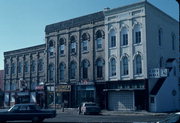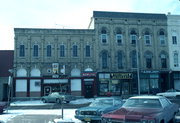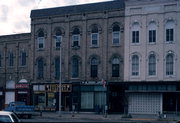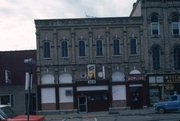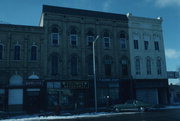| Additional Information: | A 'site file' exists for this property. It contains additional information such as correspondence, newspaper clippings, or historical information. It is a public record and may be viewed in person at the Wisconsin Historical Society, State Historic Preservation Office.
Lakin was the builder. 1103 (Lakin Block) was later the Kirkpatrick block, and after 1905 City Hall. 1105-1107 (McNair Block) was later National Hall, a dry goods store, and public hall. 1111 (Broughton Opera House) was later also part of the public hall. The opera house portion of this block has been demolished.
The three story brick Putnam Block, located on the west side of Exchange Square, exhibits the tall proportions and elaborate detail of the commercial Victorian Italianate style popular in the late 19th century. Four brick pilasters, joined at their capitols by a string course, rise through the upper stories providing vertical emphasis and dividing the front facades into three bays. (The side facade is punctuated with round headed windows but has no pilasters). Tall and narrow windows are capped by rounded hoods keystones. Brick detailing, simulating denticulation, ornaments the cornice.
Built in the 1860s, the building is an architecturally significant example of the commercial Italianate style in Green County.
Built sometime between 1869 and 1871, the Putnam Block was home to several dry goods stores throughout the late 19th century including the firm of H.D. Kirkpatrick (by 1890). But the building took on new significance early in the 20th century when H.C. Putnam, a leading Brodhead businessman and politician (village president in 1884 and city mayor in 1907) purchased the structure and donated it to the city in 1905 for use as a city hall, fire department, library, and GAR hall. The first floor facade was considerably remodeled in 1962 and a fire bell on top of the building was removed, but the Putnam block continues to serve as the seat of Brodhead's local government.
McNair Block (1105-1107 Second Ave.) - A complementary neighbor to the Putnam Block, this three story cream brick building is distinguished by the same commercial Italianate detailing and proportions. The facade is divided into five bays by brick pilasters which rise from the top of the first floor to the cornice where they are joined by a string course. The round headed windows are tall proportioned and surmounted by corbelled brick hoods springing from imposts. The cream brick is unpainted, giving the building a warm color and rich texture. Although the cornice and ground floor have been altered, the building retains integrity of material and design in the upper stories, and is an architecturally significant example of the commercial Italianate style in Green County. Built between 1861 and 1871, the building served as the site of a dry goods store and a Masonic Temple in the late 19th century and remained a retail store and public hall into the 20th century.
Broughton Opera House (111 W. Second Ave,): Like its neighbors on the west side of Exchange Square, the Broughton Opera House is an architecturally significant example of the commercial Italianate style in Green County. The two story cream brick building is distinguished by tall round arched windows, crowned with keystones, on the first story and segmental arched windows, surmounted with stilted segmental hoods, on the second. Thin pilasters, united at each story by a string course, divide the facade into six bays and brick details ornament the cornice. The first story windows have been partially hidden by store front remodelings. Built between 1861 and 1871, this building was used variously during the late 19th century as a skating rink, public hall, and by 1980, as the Broughton Opera House. The Hall, measuring 125 by 44 feet, occupied the first story and was capable of accommodating 1,000 people. The stage, measuring 30 by 42 feet, was equipped with a crop curtain and scenery. Traveling companies regularly appeared at the Broughton at the turn of the century, and later the house became an early Brodhead movie palace. |
|---|
| Bibliographic References: | (A) Monroe Times 8/16/1996.
(B) 1861 Map of Green County (no building appears).
(C) 1871 Bird's Eye View of Brodhead.
(D) 1887 Sanborn-Perris Map.
(E) The City of Brodhead. 1893, T.S. Sherwood, p. 62.
(F) Brodhead Independent Register, June 21, 1956.
(G) Bicentennial Book, 1976.
(H) Wally Ekum Abstract Co. |
|---|

